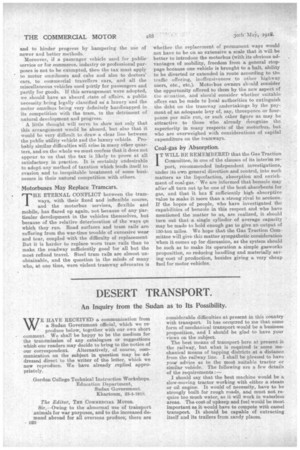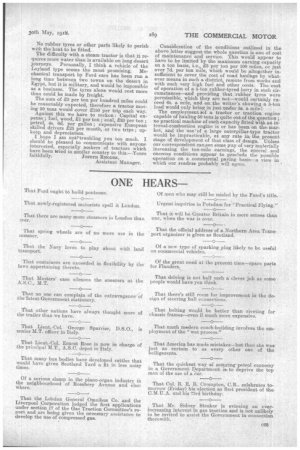DESERT TRANSPORT.
Page 2

Page 3

If you've noticed an error in this article please click here to report it so we can fix it.
An Inquiry from the Sudan as to Its Possibility.
WE HAVE RECEIVED a communication from a, Sudan Government official, which we reproduce below, together with our own short comment. We shall be happy to be the medium for the transmission of any catalogues or suggestions which our readers may decide to bring to the notice of our correspondent. Alternatively, of course, communication on the subject in question may be addressed direct to the writer of the letter, which we now reproduce. We have already replied appropriately.
Gordon College Technical Instruction Workshops. Education Department, Sudan Government. Khartoum, 23-4-1918.
The Editor, THE ,COMMEHOIAL MOTOR.
Sir —Owing to the abnormal use of traiisport animals for war purposes, and to the increased demand abroad for all overseas produce; there are
020 considerable difficulties at present in this country with transport. It has occurred to me that some form of mechanical transport would be a business proposition, and I should be glad to have your views on the subject.
The best means of transport. here at present is the railway, but what is required is some mechanical means of tapping districts at a distance from the railway line. I shall be pleased to have your advice as to the most suitable tractor or similar vehicle. The following are a few details of the requirements : .1 I should say that the best machine would be a slow-moving tractor working with either a steam or oil engine. It would of necessity, have to be strongly built for rough roads, and must not require too much water, as it will work in waterless areas. The cost of upkeep and fuel would be most important as it would have to compete with camel transport. It should be capable of extracting itself and its trailers from sandy places. No rubber tyres or other parts likely to perish with the heat to be fitted.
The difficulty with a steam tractor is that it requires more water than is available on long desert journeys. Personally, I think a vehicle of the Leyland type seems the most promising. Mechanical transport by Ford cars has been run a long time between two towns on the desert in Egypt, but it is military, and would be impossible as a business. The tyres alone would cost more than could be made by freight.
The sum of £3 per ton per hundred miles could be reasonably expected, therefore a tractor moving 50 tons -would cover .2150 per trip each way. Against this we have to reckon : Capita/ expense; fuel, wood, Li per ton ; coal, 220 per ton ; petrol, 4s. 6d. per gallon ; expensive Eunopean skilled drivers £25 per month, or two trips ; upkeep and depreciation. I Mope I am notnroubLing you too much. I should be pleased to communicate with anyone interested, especially makers of tractors which have been bried in similar country to this.--Yours faithfully. JOSEPH RHODES, Assistant Manager. Consideration of the conditions outlined in the above letter suggest the whole question is one of cost of maintenance and service. This -would appear to have to be limited by the maximum earning capacity on a ton basis, i.e., £3 per ton per 100 miles, or just over 7d. per ton mile, which would be altogether insufficient to cover the cost of road haulage by whatever means in. such a district, remote from works and with such very high fuel and other costs. The cost of operation of a 5-ton rubber-tyred lorry in such circumstances—and providing that ,rubber tyres were permissible, which they are not—would certain,ly exceed 6s. a mile, and on:the writer's showing a 5-ton load would only bring in just under 3s. a mile !
The employment )of a tractor or traction engine capable of hauling 50 tons is quite out of the question ; no practical machine of such capacity fitted with an internal-combustion engine is or has been on the market, and the use 'of a large caterpillar-type tractor would be impracticable, at any rate im the present stage of development of that class of design. Unless our correspondent can.,see some way of very materially increasing the ton-mile earnings, the special and onerous conditions appear to preclude the possible operation on a commercial paying basis—a view in which our readers-probably will agree.






















